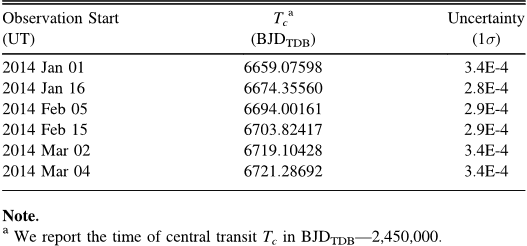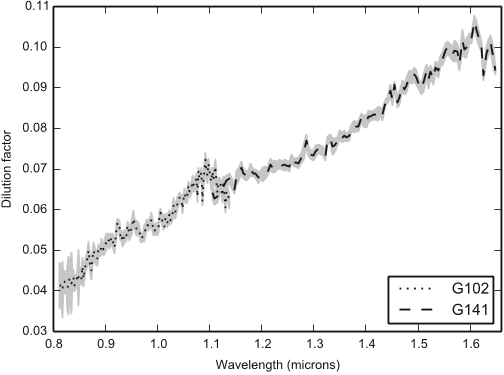A Detection of Water in the Transmission Spectrum of the Hot Jupiter WASP-12b and Implications for its Atmospheric Composition
Laura Kreidberg,Michael R. Line,Jacob L. Bean,Kevin B. Stevenson,Jean-Michel Desert,Nikku Madhusudhan,Jonathan J. Fortney,Joanna K. Barstow,Gregory W. Henry,Michael H. Williamson,Adam P. Showman +10 more
Reads0
Chats0
TLDR
In this article, a near-infrared transmission spectrum for WASP-12b based on six transit observations with the Hubble Space Telescope/Wide Field Camera 3 (HST-WFC) was reported.Abstract:
Detailed characterization of exoplanets has begun to yield measurements of their atmospheric properties that constrain the planets’ origins and evolution. For example, past observations of the dayside emission spectrum of the hot Jupiter WASP-12b indicated that its atmosphere has a high carbon-tooxygen ratio (C/O > 1), suggesting it had a dierent formation pathway than is commonly assumed for giant planets. Here we report a precise near-infrared transmission spectrum for WASP-12b based on six transit observations with the Hubble Space Telescope/Wide Field Camera 3. We bin the data in 13 spectrophotometric light curves from 0.84 - 1.67 m and measure the transit depths to a median precision of 51 ppm. We retrieve the atmospheric properties using the transmission spectrum and nd strong evidence for water absorption (7 condence). This detection marks the rst high-condence, spectroscopic identication of a molecule in the atmosphere of WASP-12b. The retrieved 1 water volume mixing ratio is between 10 5 10 2 , which is consistent with C/O > 1 to within 2 . However, we also introduce a new retrieval parameterization that ts for C/O and metallicity under the assumption of chemical equilibrium. With this approach, we constrain C/O to 0:5 +0:2 0:3 at 1 and rule out a carbon-rich atmosphere composition (C/O> 1) at > 3 condence. Further observations and modeling of the planet’s global thermal structure and dynamics would aid in resolving the tension between our inferred C/O and previous constraints. Our ndings highlight the importance of obtaining high-precision data with multiple observing techniques in order to obtain robust constraints on the chemistry and physics of exoplanet atmospheres. Subject headings: planets and satellites: atmospheres | planets and satellites: composition | planets and satellites: individual: WASP-12bread more
Figures

Table 2 Transit Times 
Figure 6. Systematics decorrelation parameters from the light curve fits plotted as a function of normalization c. We show (from top to bottom) the visit-long slope v, ramp rate constant a, ramp amplitude b, and ramp delay d. The normalization constant c is linearly proportional to the per-pixel flux in a spectroscopic channel. Measurements from the G102 and G141 data are shown in light and dark gray, respectively. The error bars indicate 1σ uncertainties from an MCMC fit to the light curves using the analytic model for instrument systematics. 
Figure 7. Dilution factor αComp, determined from the ratio of flux from WASP12 BC to WASP-12 A. The median dilution (over the 10 staring mode observations) is shown with black lines (dotted for G102 and dashed for G141). The gray shaded region indicates 1σ uncertainty, determined from the median absolute deviation. To calculate the dilution and uncertainty, we interpolate the spectra from each grism onto a common wavelength scale. 
Figure 12. Retrieval results from the C-C parameterization. The left and middle panels show the marginalized distribution for C/O and metallicity. The right panel shows the median (black lines) and 1σ range (shaded regions) of 1000 randomly sampled temperature–pressure profiles for each scenario. Yellow, blue, and red shading correspond to constraints from the fiducial scenario (an uninformative prior on C/O), the oxygen-rich scenario (C/O < 1), and a carbon-rich scenario (C/O > 1). The distribution of C/O values for the carbon-rich model is normalized to have a probability mass of unity over the plotted range; however, the distribution has an extended tail toward higher C/O values that is not shown. 
Table 1 Summary of Photometric Observations for WASP-12 
Figure 1. Raw HST/WFC3 images taken with the G102 grism. Spatial scan and staring mode data are shown in the top and bottom panels, respectively. The images are cutouts from a 256 × 256 pixel subarray. The spectrum of WASP-12A’s binary companion is visible in the bottom panel near row 10.
Citations
More filters
Journal ArticleDOI
A spectral survey of an ultra-hot Jupiter. Detection of metals in the transmission spectrum of KELT-9 b
H. J. Hoeijmakers,H. J. Hoeijmakers,David Ehrenreich,Daniel Kitzmann,Romain Allart,Simon L. Grimm,Julia V. Seidel,Aurélien Wyttenbach,Lorenzo Pino,Louise D. Nielsen,Chloe Fisher,Paul B. Rimmer,Paul B. Rimmer,Vincent Bourrier,Heather M. Cegla,Baptiste Lavie,C. Lovis,A. B. C. Patzer,Joachim Stock,Francesco Pepe,Kevin Heng +20 more
TL;DR: In this article, the optical transmission spectrum of KELT-9 b was searched for absorption lines by metals using the cross-correlation technique, and the detected absorption lines are significantly deeper than predicted by the model, suggesting that the material is transported to higher altitudes where the density is enhanced compared to a hydrostatic profile.
Journal ArticleDOI
Observing transiting planets with JWST -- Prime targets and their synthetic spectral observations
Paul Mollière,Roy van Boekel,Jeroen Bouwman,Thomas Henning,Pierre-Olivier Lagage,Michiel Min +5 more
TL;DR: In this article, the authors provide self-consistent atmospheric models and synthetic JWST observations for prime exoplanet targets in order to identify spectral regions of interest and estimate the number of transits needed to distinguish between model setups.
Journal ArticleDOI
Forward and inverse modeling of the emission and transmission spectrum of gj 436b: investigating metal enrichment, tidal heating, and clouds
Caroline V. Morley,Caroline V. Morley,Heather A. Knutson,Michael R. Line,Jonathan J. Fortney,Daniel Thorngren,Mark S. Marley,Dillon Teal,Roxana Lupu +8 more
TL;DR: In this article, the authors used a dual-pronged modeling approach of self-consistent and retrieval models to analyze the Spitzer thermal emission photometry and Hubble WFC3 transmission spectrum.
Journal ArticleDOI
High-temperature condensate clouds in super-hot Jupiter atmospheres
Hannah R. Wakeford,Channon Visscher,Nikole K. Lewis,Tiffany Kataria,Mark S. Marley,J. J. Fortney,Avi Mandell +6 more
TL;DR: In this article, the role of the initial Al and Ti-bearing condensates as the main source of cloud material is investigated. But the authors focus on super-hot Jupiters, where a majority of the more common refractory material is not depleted into deeper layers and would remain in the vapor phase.
Journal ArticleDOI
The Apparently Decaying Orbit of WASP-12b
TL;DR: In this paper, the authors presented new transit and occultation times for the hot Jupiter WASP-12b, which are compatible with a constant period derivative: ms yr−1 and.
References
More filters
Journal ArticleDOI
emcee: The MCMC Hammer
TL;DR: The emcee algorithm as mentioned in this paper is a Python implementation of the affine-invariant ensemble sampler for Markov chain Monte Carlo (MCMC) proposed by Goodman & Weare (2010).
Journal ArticleDOI
The Chemical Composition of the Sun
TL;DR: The solar chemical composition is an important ingredient in our understanding of the formation, structure, and evolution of both the Sun and our Solar System as discussed by the authors, and it is an essential refer...
Journal ArticleDOI
emcee: The MCMC Hammer
TL;DR: This document introduces a stable, well tested Python implementation of the affine-invariant ensemble sampler for Markov chain Monte Carlo (MCMC) proposed by Goodman & Weare (2010).
Journal ArticleDOI
Analytic Lightcurves for Planetary Transit Searches
Kaisey S. Mandel,Eric Agol +1 more
TL;DR: In this paper, exact analytic formulae for the eclipse of a star described by quadratic or nonlinear limb darkening are presented for the HST observations of HD 209458, showing that the ratio of the planetary to stellar radii is 0.1207+-0.0003.
Journal ArticleDOI
Analytic Light Curves for Planetary Transit Searches
Kaisey S. Mandel,Eric Agol +1 more
TL;DR: In this paper, the exact analytic formulae for the eclipse of a star described by quadratic or nonlinear limb darkening were presented, and the authors applied these results to the Hubble Space Telescope observations of HD 209458, showing that the ratio of the planetary to stellar radii is 0.1207 ± 0.0003.
Related Papers (5)
A continuum from clear to cloudy hot-Jupiter exoplanets without primordial water depletion
David K. Sing,Jonathan J. Fortney,Nikolay Nikolov,Hannah R. Wakeford,Tiffany Kataria,Thomas M. Evans,Suzanne Aigrain,Gilda E. Ballester,Adam Burrows,Drake Deming,Jean-Michel Desert,Neale P. Gibson,Gregory W. Henry,Catherine M. Huitson,Heather Knutson,Alain Lecavelier des Etangs,Frederic Pont,Adam P. Showman,Alfred Vidal-Madjar,Michael H. Williamson,Paul Wilson +20 more
INFRARED TRANSMISSION SPECTROSCOPY OF THE EXOPLANETS HD 209458b AND XO-1b USING THE WIDE FIELD CAMERA-3 ON THE HUBBLE SPACE TELESCOPE
Drake Deming,Drake Deming,A. Wilkins,Peter R. McCullough,Adam Burrows,Jonathan J. Fortney,Eric Agol,Eric Agol,Ian Dobbs-Dixon,Ian Dobbs-Dixon,Nikku Madhusudhan,Nicolas Crouzet,Jean-Michel Desert,Ronald L. Gilliland,Korey Haynes,Korey Haynes,Heather Knutson,Michael R. Line,Zazralt Magic,Avi Mandell,Sukrit Ranjan,David Charbonneau,Mark Clampin,Sara Seager,Adam P. Showman +24 more
Infrared Transmission Spectroscopy of the Exoplanets HD209458b and XO-1b Using the Wide Field Camera-3 on the Hubble Space Telescope
Drake Deming,Ashlee Wilkins,Peter R. McCullough,Adam Burrows,Jonathan J. Fortney,Eric Agol,Ian Dobbs-Dixon,Nikku Madhusudhan,Nicolas Crouzet,Jean-Michel Desert,Ronald L. Gilliland,Korey Haynes,Heather Knutson,Michael R. Line,Zazralt Magic,Avi Mandell,Sukrit Ranjan,David Charbonneau,Mark Clampin,Sara Seager,Adam P. Showman +20 more